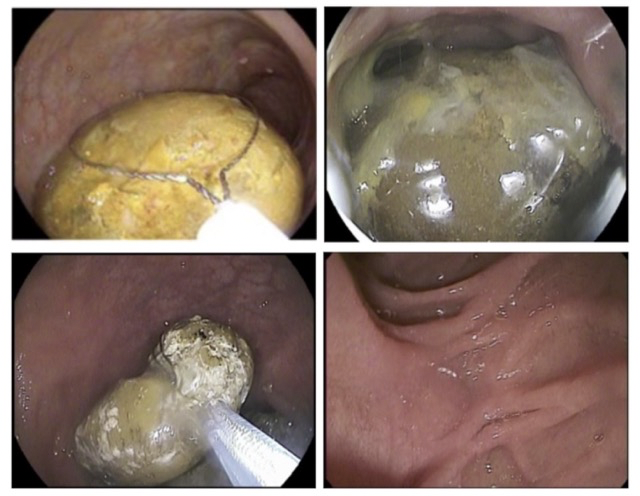Sunday Poster Session
Category: Colon
P0436 - No Scalpel, No Problem: Endoscopic Resolution of Colonic Gallstone Ileus
Sunday, October 26, 2025
3:30 PM - 7:00 PM PDT
Location: Exhibit Hall
- AM
Antony Mathew, MD
Methodist Dallas Medical Center
Irving, TX
Presenting Author(s)
Antony Mathew, MD1, Paul Tarnasky, MD2
1Methodist Dallas Medical Center, Irving, TX; 2Methodist Dallas Medical Center, Dallas, TX
Introduction: Colonic gallstone ileus is a rare complication of cholelithiasis leading to large bowel obstruction. We present a case of colonic gallstone ileus successfully treated with endoscopic lithotripsy.
Case Description/
Methods: A 46-year-old male was referred for chronic constipation. He reported difficulty passing stools for 5 years, but his symptoms worsened over the last 3 months. He also reported excessive straining, a sense of incomplete evacuation and few episodes of blood when wiping. Furthermore, he had lost 5 lbs over the past year. He had trialed daily to BID Miralax and Senna for months at a time with no improvement. He had a colonoscopy done over 15 years ago for constipation, but the patient was unsure of the findings. Initial colonoscopy revealed two ~3 cm stones impacted in the rectum. These stones were unable to be removed manually or with accessories. A repeat colonoscopy again showed two large gallstones impacted in the distal rectum. EHL was attempted but the stones did not fragment. Four mechanical lithotripsy baskets and laser lithotripsy via Spyscope were used to fragment stones, but the stones were unable to be extracted. The p</span>atient underwent 4 additional colonoscopies with mechanical and laser lithotripsy over the next 4 weeks. Eventually, all the stones and fragments were successfully extracted and removed. Additionally, a CT abdomen showed no evidence of a fistula. However, an EGD revealed a duodenal scar consistent with a healed cholecystoduodenal fistula.
Discussion: Gallstone ileus is a rare complication of cholelithiasis. Entry into the GI tract occurs at the site of a fistula, with cholecystoduodenal being the most common (68%). Obstruction occurs when the stone becomes impacted within the intestinal lumen, with the IC valve being the most common site (73%). Historically, the treatment for gallstone ileus has been primarily surgical. Recent developments have highlighted the advantages of less invasive endoscopic methods, which offer shorter recovery times. As such endoscopy and lithotripsy may be a practical first-line strategy for management of gallstone ileus.

Figure: Image 1: Endoscopic images of impacted colonic gallstone and duodenal scar
Disclosures:
Antony Mathew indicated no relevant financial relationships.
Paul Tarnasky indicated no relevant financial relationships.
Antony Mathew, MD1, Paul Tarnasky, MD2. P0436 - No Scalpel, No Problem: Endoscopic Resolution of Colonic Gallstone Ileus, ACG 2025 Annual Scientific Meeting Abstracts. Phoenix, AZ: American College of Gastroenterology.
1Methodist Dallas Medical Center, Irving, TX; 2Methodist Dallas Medical Center, Dallas, TX
Introduction: Colonic gallstone ileus is a rare complication of cholelithiasis leading to large bowel obstruction. We present a case of colonic gallstone ileus successfully treated with endoscopic lithotripsy.
Case Description/
Methods: A 46-year-old male was referred for chronic constipation. He reported difficulty passing stools for 5 years, but his symptoms worsened over the last 3 months. He also reported excessive straining, a sense of incomplete evacuation and few episodes of blood when wiping. Furthermore, he had lost 5 lbs over the past year. He had trialed daily to BID Miralax and Senna for months at a time with no improvement. He had a colonoscopy done over 15 years ago for constipation, but the patient was unsure of the findings. Initial colonoscopy revealed two ~3 cm stones impacted in the rectum. These stones were unable to be removed manually or with accessories. A repeat colonoscopy again showed two large gallstones impacted in the distal rectum. EHL was attempted but the stones did not fragment. Four mechanical lithotripsy baskets and laser lithotripsy via Spyscope were used to fragment stones, but the stones were unable to be extracted. The p</span>atient underwent 4 additional colonoscopies with mechanical and laser lithotripsy over the next 4 weeks. Eventually, all the stones and fragments were successfully extracted and removed. Additionally, a CT abdomen showed no evidence of a fistula. However, an EGD revealed a duodenal scar consistent with a healed cholecystoduodenal fistula.
Discussion: Gallstone ileus is a rare complication of cholelithiasis. Entry into the GI tract occurs at the site of a fistula, with cholecystoduodenal being the most common (68%). Obstruction occurs when the stone becomes impacted within the intestinal lumen, with the IC valve being the most common site (73%). Historically, the treatment for gallstone ileus has been primarily surgical. Recent developments have highlighted the advantages of less invasive endoscopic methods, which offer shorter recovery times. As such endoscopy and lithotripsy may be a practical first-line strategy for management of gallstone ileus.

Figure: Image 1: Endoscopic images of impacted colonic gallstone and duodenal scar
Disclosures:
Antony Mathew indicated no relevant financial relationships.
Paul Tarnasky indicated no relevant financial relationships.
Antony Mathew, MD1, Paul Tarnasky, MD2. P0436 - No Scalpel, No Problem: Endoscopic Resolution of Colonic Gallstone Ileus, ACG 2025 Annual Scientific Meeting Abstracts. Phoenix, AZ: American College of Gastroenterology.
